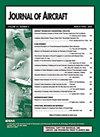无人机非对称串联机翼结构的实验研究
IF 2.1
3区 工程技术
Q2 ENGINEERING, AEROSPACE
引用次数: 0
摘要
提出了一种低速风洞试验方法,用于表征非对称串联机翼的性能。风洞数据由数值模拟和流动可视化支持。矩形机翼的对半部分沿中央机身有系统地前后移动,以产生不对称。结果表明,不对称对升力曲线斜率、最小阻力系数和奥斯瓦尔德效率因子的影响较小,数值计算支持了这一结果。然而,最大升阻比随着不对称性的增加而呈线性下降,这是由于每个机翼的展弦比减小,从而降低了最小阻力的升力系数。与传统尾翼对称机翼的实验结果比较表明,非对称串联机翼结构可能是一种可行的可展开飞行器(如管射无人机)的几何结构。本文章由计算机程序翻译,如有差异,请以英文原文为准。
Experimental Study of an Asymmetric Tandem Wing Configuration for Drone Application
A low-speed wind tunnel investigation characterizing the performance of an asymmetric tandem wing is presented. Wind tunnel data were supported by numerical modeling and flow visualization. The opposing wing halves of a rectangular [Formula: see text] wing were systematically shifted fore and aft along a central fuselage to yield asymmetry. The results show that the lift curve slope, minimum drag coefficient, and Oswald efficiency factor are weakly affected by asymmetry, a result supported by numerical computations. The maximum lift-to-drag ratio, however, dropped essentially linearly with increasing asymmetry, a consequence of the reduced aspect ratio of each wing half decreasing the lift coefficient for minimum drag. Comparison of the experimental results with a symmetric wing with conventional empennage suggests that an asymmetric tandem wing configuration may be a viable geometry for deployable flight vehicles such as tube-launched drones.
求助全文
通过发布文献求助,成功后即可免费获取论文全文。
去求助
来源期刊

Journal of Aircraft
工程技术-工程:宇航
CiteScore
4.50
自引率
31.80%
发文量
141
审稿时长
6 months
期刊介绍:
This Journal is devoted to the advancement of the applied science and technology of airborne flight through the dissemination of original archival papers describing significant advances in aircraft, the operation of aircraft, and applications of aircraft technology to other fields. The Journal publishes qualified papers on aircraft systems, air transportation, air traffic management, and multidisciplinary design optimization of aircraft, flight mechanics, flight and ground testing, applied computational fluid dynamics, flight safety, weather and noise hazards, human factors, airport design, airline operations, application of computers to aircraft including artificial intelligence/expert systems, production methods, engineering economic analyses, affordability, reliability, maintainability, and logistics support, integration of propulsion and control systems into aircraft design and operations, aircraft aerodynamics (including unsteady aerodynamics), structural design/dynamics , aeroelasticity, and aeroacoustics. It publishes papers on general aviation, military and civilian aircraft, UAV, STOL and V/STOL, subsonic, supersonic, transonic, and hypersonic aircraft. Papers are sought which comprehensively survey results of recent technical work with emphasis on aircraft technology application.
 求助内容:
求助内容: 应助结果提醒方式:
应助结果提醒方式:


